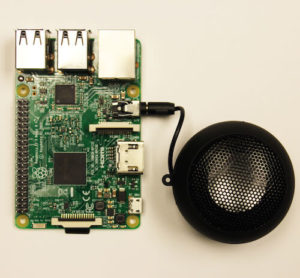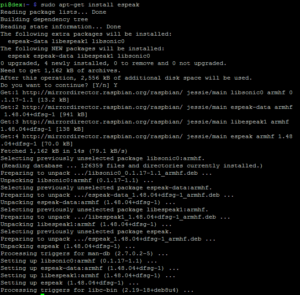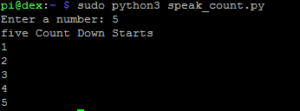 Introduction: Make Your Raspberry Pi Speak!
Introduction: Make Your Raspberry Pi Speak!
Sometimes your robot just wants to talk! This tutorial will show you how to make your Raspberry Pi speak aloud. We will use a software package called Espeak to convert text (or strings) into spoken words, out loud, on your robot. We show you three examples:
- How to create a countdown.
- How to modify the voice.
- Modify the voice for speed, language, and gender.
Video
Here’s a quick video that summarizes the information below and walks you through step by step on getting the Raspberry Pi to speak aloud.
Materials You’ll Need

Dexter Industries Speakers
All the instructions assume you’re using Raspbian for Robots, our custom operating system for the Raspberry Pi based on Raspbian. You can buy an SD Card with Raspbian for Robots on it here, or you can download it for free and install it using our directions here.
Software
This tutorial uses python3. It can be adapted to earlier versions of python.
Connections
- Make sure your Raspberry Pi is powered up and connected to your network.
- Connect the speaker to the audio jack as shown in the image.
 Setting up the TTS (Text To Speech) Engine
Setting up the TTS (Text To Speech) Engine
To make the Raspberry Pi speak and read some text aloud, we need a software interface to convert text to speech on the speakers. For this we need a Text To Speech engine. The TTS engine we are using in this tutorial is eSpeak. The voice may be a little robotic, however it runs offline which is an added plus.
First let’s test if the audio is working on the Raspberry Pi. Run the following command:
aplay /usr/share/sounds/alsa/*
If you are able to hear the sounds like “Front Center”,”Front Left”, “Front Right” and so on, your sound is working!
Next, install eSpeak. Run the following in terminal to install espeak:
sudo apt-get install espeak
Get the Raspberry Pi Speaking from the Command Line
After eSpeak has been successfully installed on the Raspberry Pi, run the following command to test eSpeak:
espeak "Text you wish to hear back" 2>/dev/null
For example:
espeak "Hello World" 2>/dev/null
You should hear “Hello World” from the speakers. Your Raspberry Pi is speaking!
Using Python to Make Your Raspberry Pi Speak
Now building on top of these commands you can create Python programs that speak words. We have two examples that you can download here:
- speak_count.py – This program reads aloud a countdown. The program prompts you for a number, and then counts off the numbers out loud until it reaches 0.
- speak_text.py – This program reads aloud the text you enter and it also records the speech to a file named Text.wav.
Running the Example Programs:
Counting Numbers
Connect your Pi to the internet. You will need to download and install the num2words Python package to convert the numbers to strings. This will convert an integer value to a string, which are then read aloud by the Raspberry Pi. Use the following command:
sudo pip3 install num2words
Go to the folder where you have copied the examples and run the following command:
sudo python3 speak_count.py
Enter a number and you should hear a voice saying “Count Down Starts”, then you should hear numbers counted down from the entered number.

Speaking Commands
Run the program “speak_text.py” in the command line:
sudo python3 speak_text.py
When prompted, enter some text you wish to hear back. You should see the text you have entered and you will hear it back through your speakers!
Sample output is shown below.

As a bonus, this example also records the voice to a file named Text.wav.
Run the following commands to hear back the recorded voice.
aplay /home/pi/Desktop/Text.wav
A Deeper Dive on Raspberry Pi Speech: More Options
Modifying the Voice
The Espeak package provides a few good variations to the default voice used to speak out the text. The software supports more than 30 languages and a few of them are shown below. The syntax is “-v<voice filename>” For example, we can use an American accent with “en-us”:
espeak -ven-us "Welcome to Dexter tutorial" 2>/dev/null
Or we can use a French accent with “fr”:
espeak -vfr "Ce tutoriel de Dexter vous souhaite la bienvenue" 2>/dev/null
Or we can speak Spanish with the Raspberry Pi using the term “es”:
espeak -ves "Bienvenido al tutorial de Dexter" 2>/dev/null
Voices
You can also specify a male voice, or a female voice. You can choose between a few different male voices :+m1,+m2,+m3,+m4,+m5,+m6,+m7. For example, we can speak in male voice five:
espeak -ven+m5 "Welcome to Dexter tutorial" 2>/dev/null
You can also use female voices: +f1,+f2,+f3,+f4. For example, we can speak in female voice four:
espeak -ven+f4 "Welcome to Dexter tutorial" 2>/dev/null
You can also modify a few other aspects of the voice with +croak, +whisper. For example, we can whisper:
espeak -ven+whisper "Welcome to Dexter tutorial" 2>/dev/null
Modifying Speech Speed
The “-s” parameter controls the speed of reading a single word. It sets the speed in words-per-minute. The default value is 175. I generally use a faster speed of 260. The lower limit is 80. There is no upper limit, but about 500 is probably a practical maximum. We can set the word speed like this:
Fast at 300 words per minute:
espeak -s250 "Welcome to Dexter tutorial" 2>/dev/null
Or slow at 80 words per minute:
espeak -s80 "Welcome to Dexter tutorial" 2>/dev/null
Pause Between Words
We can use the “-g” to pause between words; the “g” stands for “word gap”. This option inserts a pause between words. The value is the length of the pause, in units of 10 ms (at the default speed of 170 wpm). A fast pause:
espeak -g10 "Welcome to Dexter tutorial" 2>/dev/null
A slow pause with 100 ms between words:
espeak -g180 "Welcome to Dexter tutorial" 2>/dev/null
There are lot more options available with the eSpeak package you can review here.
Questions About Your Speaking Raspberry Pi?
You can use these examples to build your own TTS powered projects and make the Raspberry Pi Speak. Please share any interesting projects that you build with us on the forums here!
Learn More!
If you liked our tutorial, consider getting the Pi Speakers, Raspberry Pi, Raspbian for Robots to try it out yourself!
EDUCATORS
Check out our DexterEd page to learn about our Classroom Kits, Curriculum and Teacher Trial program.


